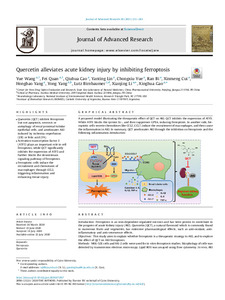Please use this identifier to cite or link to this item:
https://repositorio.uca.edu.ar/handle/123456789/11638| Título: | Quercetin alleviates acute kidney injury by inhibiting ferroptosis | Autor: | Wang, Yue Quan, Fei Cao, Qiuhua Lin, Yanting Yue, Chongxiu Bi, Ran Cui, Xinmeng Yang, Hongbao Yang, Yong Birnbaumer, Lutz Li, Xianjing Gao, Xinghua |
Palabras clave: | FERROPTOSIS; MUERTE CELULAR REGULADA; QUERCETINA; LESION RENAL AGUDA; MACROFAGOS DEL HIGADO | Fecha de publicación: | 2021 | Editorial: | Elsevier | Cita: | Wang, Y., et al. Quercetin alleviates acute kidney injury by inhibiting ferroptosis [en línea]. Journal of Advanced Research. 2021, 28. doi:10.1016/j.jare.2020.07.007. Disponible en: https://repositorio.uca.edu.ar/handle/123456789/11638 | Resumen: | Abstract: Introduction: Ferroptosis is an iron-dependent regulated necrosis and has been proven to contribute to the progress of acute kidney injury (AKI). Quercetin (QCT), a natural flavonoid which is commonly found in numerous fruits and vegetables, has extensive pharmacological effects, such as anti-oxidant, antiinflammatory and anti-senescence effects. Objectives: This study aims to explain whether ferroptosis is a therapeutic strategy to AKI, and to explore the effect of QCT on AKI ferroptosis. Methods: NRK-52E cells and HK-2 cells were used for in vitro ferroptosis studies. Morphology of cells was detected by transmission electron microscopy. Lipid ROS was assayed using flow cytometry. In vivo, AKI was induced by ischemia–reperfusion (I/R) or folic acid (FA). To explore the molecular mechanisms, RNA-sequence analysis was performed. Transwell was used to detect macrophage migration. Results: We discovered that quercetin (QCT), a natural flavonoid, inhibited ferroptosis in renal proximal tubular epithelial cells. QCT blocked the typical morphologic changes of ferroptotic cells by reducing the levels of malondialdehyde (MDA) and lipid ROS and increasing the levels of glutathione (GSH). Moreover, QCT ameliorated AKI induced by I/R or FA. RNA-sequence analysis highlighted activation transcription factor 3 (ATF3), as it was the dominant one among all the 299 down-regulated genes by QCT. Knockdown of ATF3 could significantly increase the levels of SLC7A11, GPX4 and increased the cell viability. In addition, ferroptotic cells were found to be extremely pro-inflammatory by recruiting macrophages through CCL2, while QCT inhibited the chemotaxis of macrophages induced by ferroptosis in AKI. Conclusions: Collectively, these results identify QCT as a ferroptosis inhibitor and provide new therapeutic strategies for diseases related to ferroptosis. | URI: | https://repositorio.uca.edu.ar/handle/123456789/11638 | ISSN: | 2090-1232 | Disciplina: | MEDICINA | DOI: | https://doi.org/10.1016/j.jare.2020.07.007 | Derechos: | Acceso abierto | Fuente: | Journal of Advanced Research Vol. 28, 2021 |
| Appears in Collections: | Artículos |
Files in This Item:
| File | Description | Size | Format | |
|---|---|---|---|---|
| quercetin-alleviates-acute- kidney.pdf | 4,9 MB | Adobe PDF |  View/Open |
Page view(s)
152
checked on Apr 27, 2024
Download(s)
391
checked on Apr 27, 2024
Google ScholarTM
Check
Altmetric
Altmetric
This item is licensed under a Creative Commons License

